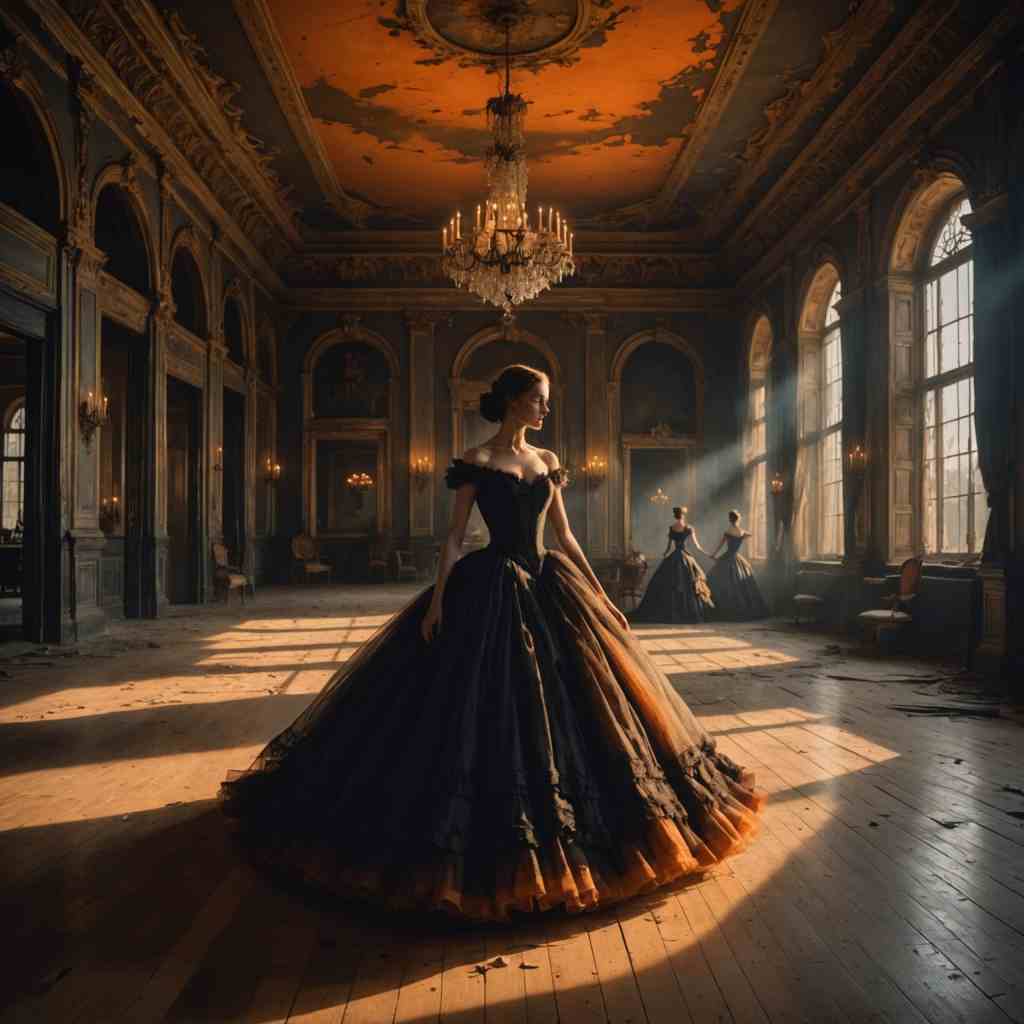Lament for the Crinoline's Flame
Richard

Oh, garments vast, with folds that sweep,
Like ocean waves in twilight deep,
Thy beauty hides a dreadful snare,
A fiery fate beyond compare.
The crinoline, with pride adorned,
A queenly frame by fashion mourned,
Yet in thy breadth, the embers lie,
A spark to doom, a flame to die.
See Fanny’s hands with waxen seal,
Her dress ignites—no time to heal.
The poet weeps; his muse is stilled,
By fire’s cruel hand, her life was killed.
Oscar’s sisters danced in mirth,
Their gowns aflame—a cursed birth.
The laughter turned to cries of pain,
As fire consumed the silken train.
O fashion’s folly! O vanity’s cost!
So many lives so cruelly lost.
The forest primeval mourns thy plight,
Its pines and hemlocks wail at night.
Let us not forget their cries,
The women caught in flame that flies.
A lesson learned from beauty’s bane:
Beware the spark; resist the flame.
So sing we now this somber tune,
Beneath the stars and waning moon.
For those who danced in fire's embrace,
May peace be theirs in heaven's grace.
Richard's Lament for the Crinoline's Flame
The Victorian era, often romanticized for its strict morality and rapid industrialization, harbored a darker undercurrent of peril woven into the fabric of everyday life. “Lament for the Crinoline’s Flame” emerges as a haunting elegy for the thousands of women who perished due to the era’s most infamous fashion trend: the flammable crinoline. Through vivid imagery, historical allusion, and a mournful tone, the poem interrogates the intersection of beauty, vanity, and mortality, offering a searing critique of societal norms that prioritized aesthetics over safety. By anchoring its lament in specific tragedies—such as the deaths of Fanny Longfellow and Oscar Wilde’s half-sisters—the poem transforms statistical horror into intimate grief, inviting readers to confront the human cost of sartorial conformity.
A sad accident,which proved fatal yesterday forenoon, befel Mrs. FANNY LONGFELLOW, wife of Prof. HENRY W. LONGFELLOW, at their residence in Cambridge, on Tuesday afternoon. While seated at her library table, making seals for the entertainment of her two youngest children, a match or piece of lighted paper caught her dress, and she was in a moment enveloped in flames. Prof. LONGFELLOW, who was in his study, ran to her assistance, and succeeded in extinguishingthe flames, with considerable injury to himself, but too late for the rescue of her life. Drs. WYMAN and JOHNSON, of Cambridge, and HENRY J. BIGELOW, of this city, were summoned, and did all that surgical skill could do. Both of the sufferers were under the influence of ether through the night, and yesterday morning Mrs. LONGFELLOW rallied a little, but at 11 o'clock she was forever released from suffering. Mrs. LONGFELLOW was a gifted and accomplished lady, the daughter of Hon. NATHAN APPLETON. She leaves five children to mourn, with their father, their common loss.
Prof. LONGFELLOW's injuries, though serious, are not of a dangerous kind. -- Boston Daily Advertiser, July 11.
Historical Context: Fashion as Funeral Pyre
The crinoline, a cage-like structure designed to expand skirts to dramatic widths, became a symbol of Victorian femininity in the 1850s–1860s. Made from flammable materials like cotton, gauze, and horsehair, these garments turned wearers into “walking tinderboxes”[1][9]. The poem’s opening stanza, “Oh, garments vast, with folds that sweep, / Like ocean waves in twilight deep,” captures the crinoline’s visual grandeur while subtly evoking its lethal potential. The simile “ocean waves” mirrors period descriptions of crinolines as “billowing” and “voluminous,” yet the “twilight deep” foreshadows the darkness these garments invited[1][9].
Historical records corroborate the poem’s grim subject. Florence Nightingale estimated 630 crinoline fire deaths in 1863–1864 alone, while broader estimates suggest 3,000 fatalities in England over two decades[1][9]. These tragedies transcended class: kitchen maids like Margaret Davey and aristocrats like Archduchess Mathilde of Austria alike fell victim[1][9]. The poem’s reference to Fanny Longfellow—who died in 1861 after sealing envelopes near a candle—directly echoes The New York Times’ account of her death, where “a match or piece of lighted paper caught her dress”[1]. By naming specific victims, the poet grounds abstract statistics in visceral reality, much like Thomas Hardy’s elegiac verses for rural lives lost to industrialization[5].
Literary Devices: Fire as Metaphor and Menace
The poem employs fire as both literal threat and metaphorical crucible. The crinoline becomes a “dreadful snare” and “fiery fate,” with its “embers” lying dormant in the fabric of daily life. This duality mirrors Victorian societal tensions: fire symbolized domestic comfort (hearths, candles) even as it harbored lethal unpredictability. The oxymoron “beauty’s bane” encapsulates this paradox, critiquing a culture that equated femininity with self-destructive aesthetics[1][9].
Imagery of entrapment recurs throughout. The crinoline’s “swing[ing] motion” (a direct nod to historical accounts of skirts brushing hearths)[2] morphs into a “cursed birth” of flames. This evokes the era’s constrained gender roles: women, though visually dominant in their expansive dresses, remained socially and physically immobilized. The poem’s structure reinforces this entrapment through relentless quatrains, each stanza a tightening circle around its subjects, much like the “cage crinoline” itself[2][9].
Allusion serves as both tribute and indictment. The “forest primeval” invokes Longfellow’s Evangeline—a deliberate intertextual nod to Fanny’s widowhood—while subverting its romanticism into a “wail” of collective mourning[4][6]. Similarly, the invocation of “Oscar’s sisters” (Emily and Mary Wilde) ties the poem to a broader cultural memory, their 1871 Halloween party death immortalized in press reports as a cautionary tale[1][9].
Themes: Vanity, Vulnerability, and Societal Complicity
At its core, the poem interrogates vanity’s deadly consequences, but avoids simplistic moralizing. Instead, it implicates a society that valorized female self-sacrifice. The line “O fashion’s folly! O vanity’s cost!” echoes coroner Edwin Lankester’s 1863 condemnation of crinolines as “dangerous vanity”[2], yet the poem deepens this critique by framing victims as both complicit and coerced. The “freedom” of wider skirts—often marketed as liberating for women’s movement—becomes ironic, as wearers found themselves trapped by their own garments[1][2].
This tension between agency and oppression mirrors Victorian debates over women’s roles. While Christina Rossetti’s “No, Thank You, John” asserted female autonomy[8], the crinoline’s ubiquity suggests limited choice: to reject the trend was to risk social marginalization. The poem’s lament thus becomes not just for lives lost, but for a system that demanded women “dance in fire’s embrace” to fulfill gendered expectations.
Emotional Impact: From Spectacle to Empathy
Victorian media often sensationalized crinoline deaths as moral fables, but the poem humanizes victims through intimate vignettes. Fanny Longfellow’s act of “making seals” for her children transforms her from a statistic into a mother, her death rupturing domestic tranquility. The Wilde sisters’ demise—midst Halloween “mirth”—juxtaposes festivity with horror, evoking the era’s fascination with the macabre[1][9].
The closing stanza’s shift to collective memory (“Let us not forget their cries”) invites contemporary reflection. Unlike Tennyson’s abstract “In Memoriam,” this poem demands accountability, its imperative mood (“Beware the spark”) echoing reformists like Nightingale who advocated for safer fabrics[9]. The final image of peace “in heaven’s grace” offers scant comfort, instead underscoring earthly failures to protect women.
Comparative and Philosophical Dimensions
The poem’s elegiac tone aligns with Victorian mourning poetry, yet its focus on preventable tragedy distinguishes it from works like Elizabeth Barrett Browning’s spiritual sonnets[8]. Where Browning’s “How do I love thee?” transcends mortality, “Lament” remains rooted in bodily vulnerability, closer to Hardy’s bleak realism in Satires of Circumstance[5].
Philosophically, the poem engages with what Susan Sontag later termed “aesthetic mortality”—the deadly consequences of beauty standards. The crinoline, like foot-binding or corsetry, becomes a technology of gender performance that literalizes the “consumption” of women by patriarchal ideals. The flames that “envelop” victims metaphorize societal pressures that left women no exit from prescribed roles.
Conclusion: Elegy as Activism
“Lament for the Crinoline’s Flame” transcends memorialization to become a call for vigilance. By intertwining historical fact with poetic lament, it challenges readers to scrutinize modern parallels—from flammable fast fashion to restrictive beauty norms. The poem’s enduring power lies in its fusion of empathy and critique: a reminder that elegance often masks exploitation, and that progress, like the crinoline’s eventual decline, demands collective courage to prioritize life over aesthetics. In giving voice to silenced victims, the poem fulfills Gillian Clarke’s definition of lament as “an expression of grief” that binds past suffering to present conscience[3], ensuring that these vanished women are remembered not as fashion casualties, but as catalysts for change.
This text was generated by AI and is for reference only. Learn more
Want to join the discussion? Reopen or create a unique username to comment. No personal details required!



Comments
No comments yet. Be the first to comment!